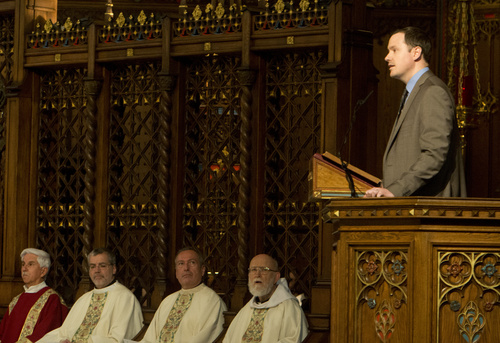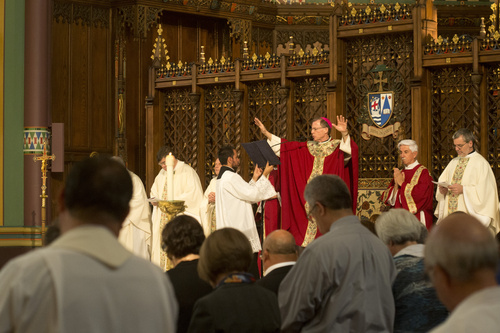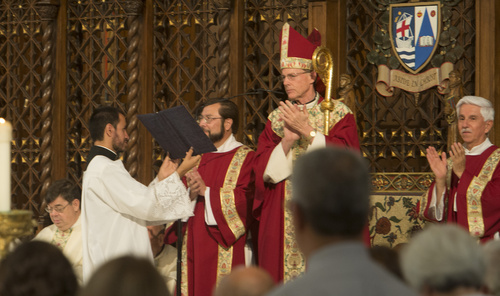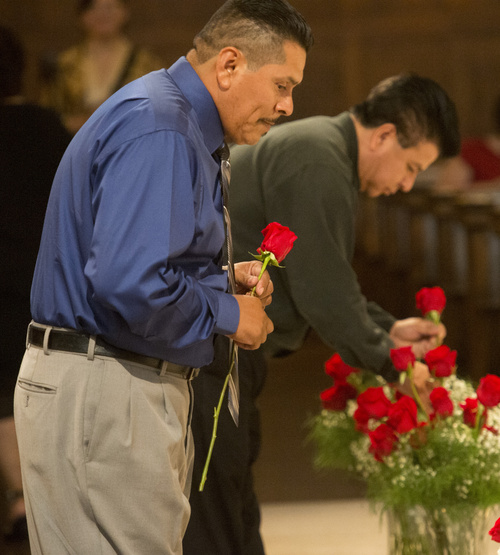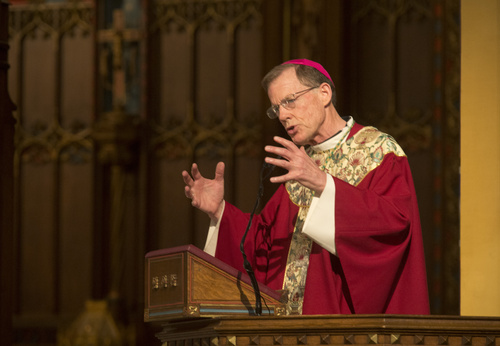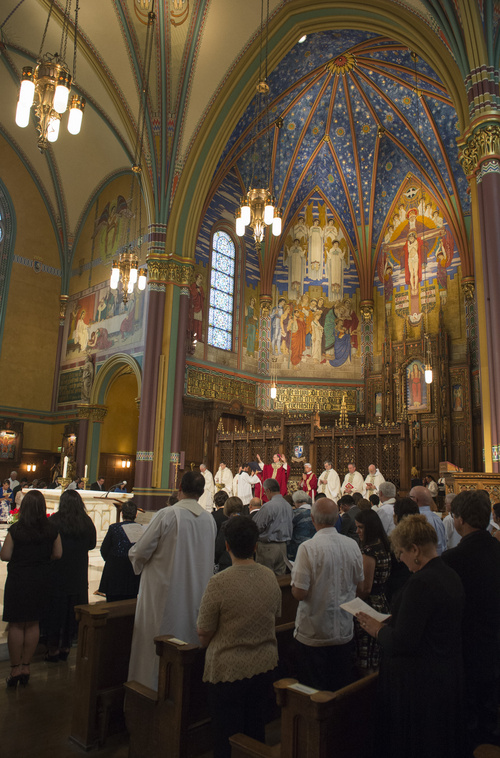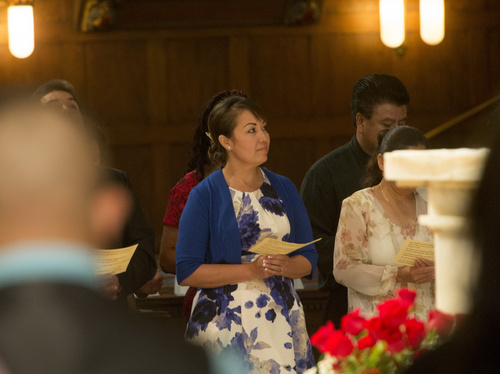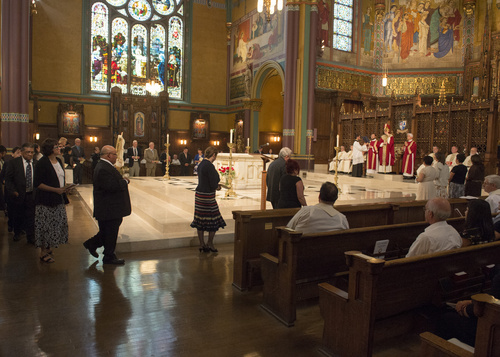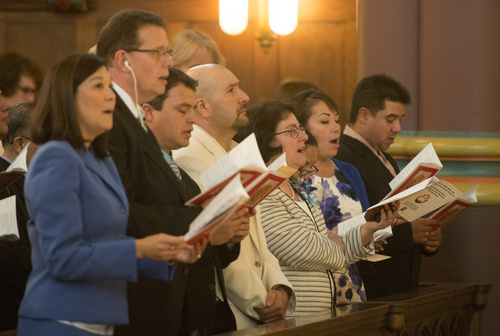This is an archived article that was published on sltrib.com in 2014, and information in the article may be outdated. It is provided only for personal research purposes and may not be reprinted.
It was no small thing for Maria Rodriguez to commit one weekend a month for four years to an endeavor of the mind, heart and soul.
And on Saturday, it all came to fruition in a joyful Mass at Salt Lake City's Cathedral of the Madeleine.
She and 62 other Spanish-speaking and 22 English-speaking Catholics were commissioned as lay ecclesial ministers. They now are equipped to be leaders in parishes and missions throughout the Salt Lake City Diocese. They cannot celebrate Mass, but they can conduct a Communion service, prepare Catholics for marriage or baptism and manage parishes.
Rodriguez, 36, has four children (including a 3-year-old born during the program) and so it was not easy to attend all those classes and spend countless hours beyond as well, learning about theology, developing a prayer life and cultivating leadership skills.
"It took a lot of family sacrifice and it was quite challenging," says Rodriguez, an immigrant from Mexico 17 years ago. A member of St. Francis Xavier Parish, she lives in West Valley City.
But, Rodriguez says, it was worth it to prepare herself to serve as a bridge between the burgeoning population of Hispanic Catholics and the much smaller population of other Utah Catholics. "Our community needs us."
Lay ministry is an outgrowth of the 1960s' Second Vatican Council, which called for rediscovering the role of the lay person in the church, says the Rev. Wayne Cavalier, director of the Congar Institute for Ministry Development in San Antonio.
The Congar Institute, named for Yves Congar, a cardinal and influential theologian at Vatican II, helps U.S. dioceses "form," or teach, lay ministers. It helped the Salt Lake City Diocese create its four-year program and sent experts on everything from canon law to ethics in ministry to teach classes in Utah.
Cavalier was one of the priests joining Saturday's Mass with Bishop John C. Wester, leader of Utah's Catholics, who commissioned the lay ministers.
"You are being recognized as leaders, but this recognition doesn't set you apart, it draws you in," Wester told the 85 new ministers, who stood as their names were called, and later surrounded the altar and together recited a promise of service, first in English and then in Spanish. The cathedral was filled with hundreds of the family members and friends.
"Ultimately, this is not about you and me," Wester says. "It's about Christ."
Commissioning such ministers is no stopgap response to the priest shortage, Wester says. But "it certainly is a great help."
"By baptism, they [all Catholics] have a call and a right to take a leadership role in the church," he says. "We need lay leaders who can get out there and bring Christ to people."
Mission country • It's remarkable that the Salt Lake City Diocese, which covers all of Utah and is considered mission country because of its dearth of Catholic culture and institutions, could pull off the four-year formation of 85 lay ministers, says Joseph Boland, vice president of mission for Catholic Extension.
That organization raises money from donors for projects in rural or Catholic mission country. It provided $250,000 for the Spanish-speakers' training here.
"Geographic distance really is a huge barrier to programs like this," Boland says.
It required extra planning and coordination, he says, to create a good learning environment and sense of community for people who live hours apart and have busy work and family lives.
"What's even more impressive," he says, "is to keep it up for four years."
The diocese's first class of lay ministers, commissioned in 2010, was comprised of 23 English speakers.
When the diocese's director of religious education, Susan Northway, and director of Hispanic ministry, Maria Cruz Gray, were discussing launching another class, they realized they needed a separate program to serve the growing Latino population. An estimated 70 percent to 80 percent of Utah's 300,000-plus Catholics are Hispanic.
Lay ministry students came from all over Utah, from Kanab to Logan, Wendover to Vernal.
English speakers took academic classes online via the University of Notre Dame's Satellite Theological Education Program and met monthly for formation in four categories: intellectual, spiritual, personal and pastoral.
Spanish speakers met monthly and had lessons from Congar Institute scholars and assorted diocesan speakers on alternating months. Their program covered the same material, but in a different way.
Not all dioceses have lay ecclesial ministers.
In 2005, the U.S. Conference of Catholic Bishops issued a pastoral letter titled "Co-Workers in the Vineyard of the Lord" to help dioceses develop such programs.
But tension continues between those who fear that elevating the role of lay people will downplay the role of ordained priests and deacons — and those who fear the opposite, Cavalier says.
"All bishops will agree that all lay [people] share responsibility for the church's mission," he says. "But not all agree to what extent they share administration."
Wester, however, is one of the bishops who is big on lay ministers.
He was on the USCCB committee that wrote the 2005 document and is the bishops' liaison to the National Association for Lay Ministry.
Wester says he is still working out how the diocese can best use the new graduates.
Most will continue in volunteer positions in their parishes and can be an aid to priests by conducting communion services when priests are not available, leading prayer, teaching catechism, and helping adult Catholics whose faith educations may have ended when they were confirmed as teenagers, he says. "This is by no means a settled ministry."
The Rev. Martin Diaz, pastor of the Cathedral parish, says one of the new ministers is already a pastoral associate in his parish, and helps people who stop by with questions.
"The life of a parish is much bigger than its sacramental life," Diaz says. "It comes out of it and it leads back to it, but the more people we have helping, the more we'll get done."
The 85 — roughly half women and half men — are now ready and equipped to serve, says Northway. "It's very much on the cutting edge of ministry."
Helping the helpers • Two women in the English-speaking class, Nancy Lorena Needham of Stansbury Park and Mary Iverson of Layton, say the four years of formation changed them.
Needham, a retired Air Force lieutenant colonel, already had a master's degree in theology when she began the program. But the training helped her, a Utah newcomer, learn about the diocese and its people.
"I got to know myself in the waiting," she says. "The wait made me stronger."
She is the Spanish choir director at St. Marguerite's Parish in Tooele and the principal of its school.
Iverson, a licensed professional counselor, joined the class because she wanted to learn more about her lifelong faith.
She once heard an author liken Catholics to consumers.
"We go and get what we need," she says, "and we leave."
She doesn't want to be that kind of Catholic.
The program gave her the confidence to begin taking Communion to inmates at the Davis County Jail, and she helps with pastoral care at Ogden Regional Medical Center.
The program, she says, "helps you grow as a whole person."
Nestor Lozano says classes taught him that sometimes he needs to curb his enthusiasm. Instead of being a full-bore, vocal witness for Christ, it's better to be a good listener, says Lozano, a construction worker who lives in West Jordan.
"I learned that sometimes, you need to be quiet," he says. "God knows the time, when, and where he wants you."
Lozano helps with the youth ministry at Midvale's St. Therese of the Child Jesus Parish.
Gray, the director of the diocese's Hispanic ministry, says it's especially important to have trained ministers in far-flung mission churches with many immigrants from Latin America.
There were eight couples among the 63 newly commissioned Spanish-speaking ministers. One of them, Rosario and Ruben Cano, help run Mission San Rafael in Huntington, where Ruben Cano is a miner. A priest comes for Mass once a month.
Lay ministers can be bridge into the church, she says — "a good bridge, solid in the information and the faith."
Twitter: @KristenMoulton —
A new class
The Salt Lake City Diocese has not decided when to begin new four-year classes to train lay ecclesial ministers. But more than 30 Catholics already have expressed interest.




